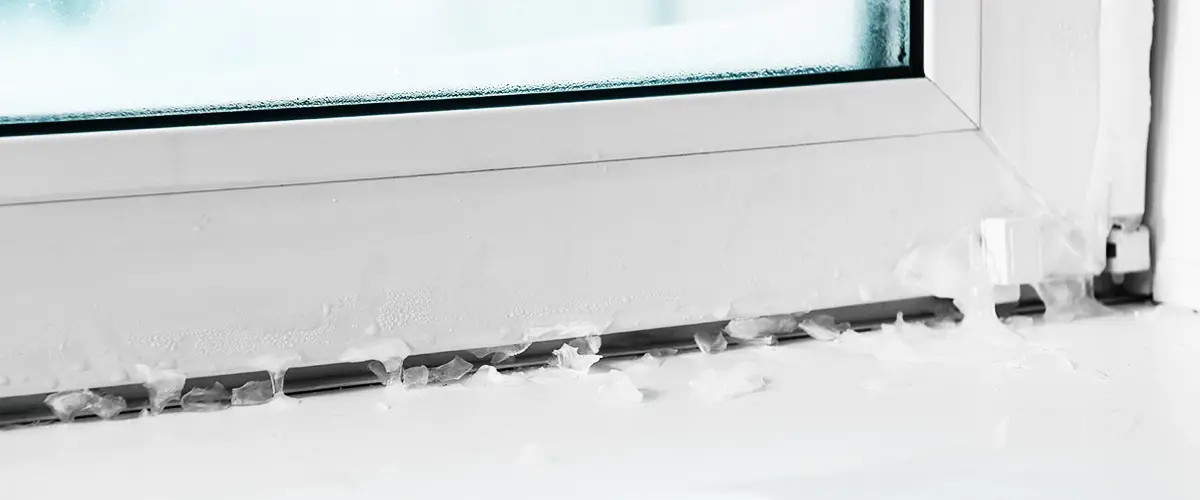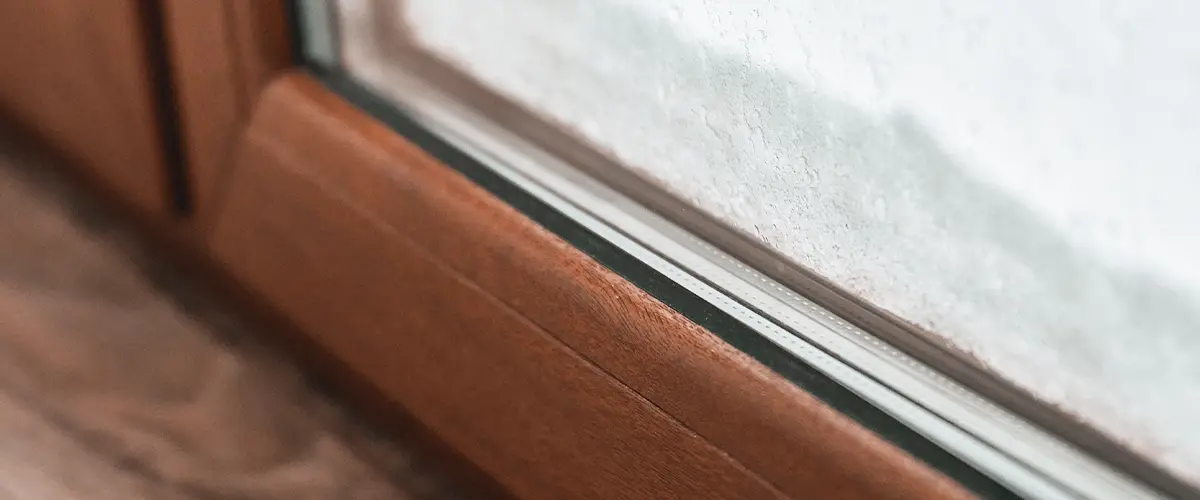When it comes to bracing for harsh winters, upgrading your home’s defense with the best windows for cold climates is a decision you won’t regret. These windows not only offer superior insulation but also reduce energy costs, enhance comfort, and increase your home’s value.
In this guide, we’ll explore the top options for replacement windows suitable for cold climates, discussing their features, benefits, and how to choose the right one for your needs. Prepare to meet the winter head-on, armed with information and the confidence to make the best decision for your home.

Key Takeaways
- Key Features for Cold Climates: Look for windows with double or triple glazing, Low-E glass coating, thermal breaks, insulated frames, gas fills, and warm edge technology for superior insulation against cold weather.
- What to Look For: Consider the Solar Heat Gain Coefficient (SHGC) for passive warming, a low U-factor for energy efficiency, low air leakage rating for airtightness, higher R-value for better insulation, and a moderate to high Visibility Transmittance (VT) for natural light.
- Window Types for Cold Climates: Casement and awning windows offer excellent energy efficiency, while fixed windows are suitable for extremely cold climates. Triple-pane and double-pane windows, as well as those with Energy Star certification, are ideal choices.
Common Window Types and Their Suitability for Cold Climates
Several window types are available in the market, each with its unique characteristics and suitability for different climates. Here, we list the most common ones and their compatibility with cold weather.
- Double-Hung Windows: These classic windows, featuring two operational sashes that move up and down, are common in many homes. However, they are not the best choice for cold climates as they can lead to significant air leakage due to the movement of both sashes.
- Casement Windows: Casement windows, hinged at the side and swinging outwards, offer excellent energy efficiency. They seal tightly when closed, making them a suitable choice for cold climates to minimize heat loss.
- Awning Windows: Similar to casement windows, awning windows are hinged at the top and open outwards. Their airtight seal, when closed, makes them a good option for cold climates, reducing heat loss.
- Sliding Windows: These windows slide horizontally in tracks. While they can offer a modern look and ease of use, they can be prone to air leakage and are not the best choice for colder regions.
- Fixed Windows: Also known as picture windows, these are non-operational windows designed to allow in light and enhance views. As there are no seams or sashes to cause air leakage, fixed windows are highly suitable for cold climates.
- Triple-Pane Windows: For extremely cold climates, triple-pane windows offer ultimate thermal efficiency. With three layers of glass and argon gas fills, they provide maximum insulation against heat loss.
- Double-Pane Windows: Double-pane windows, as the name suggests, consist of two layers of glass with a space in between filled with inert gas. This design significantly improves insulation, helping to maintain indoor temperatures in cold climates.
- Double Glazed Windows: Double-glazed windows utilize two panes of glass with a layer of gas or air trapped between them to provide a barrier against cold weather. The trapped gas, often argon, acts as an insulator, reducing heat transfer from inside to outside.
- Triple-Glazed Windows: Triple glazed windows feature three layers of glass, each separated by a gap filled with an insulating gas, typically argon or krypton. The gas acts as an excellent barrier to heat loss, maintaining a consistent indoor temperature even in extremely cold weather.
- Vinyl Windows: These frames are a great choice for cold climates due to their natural insulation properties. Unlike metal frames, they don’t conduct cold as easily, helping to keep warm air inside and cold air out. They are also moisture-resistant and low maintenance, making them a durable option for winter-ready homes.

-
Top 5 Window Manufacturers in Gallatin, TN
- Pella: Pella Corporation is a leader in designing, testing, manufacturing, and installing quality windows and doors for new construction, remodeling, and replacement applications.
- Anderson Windows: For over a century, Anderson has been a leading manufacturer of windows in the construction industry, known for its high-quality products and innovation.
- Marvin: Marvin specializes in made-to-order windows and doors. They offer various customization options to meet the energy-efficiency needs of homeowners in cold climates.
- JELD-WEN: JELD-WEN is one of the world’s leading manufacturers of reliable windows and doors. Their extensive product offering includes windows suitable for cold climates.
- MI Windows and Doors: MI Windows and Doors is one of the nation’s largest suppliers of precision-built and energy-efficient windows and has been serving customers for over 70 years with a commitment to quality and service.
Also Read About: The Different Parts Of A Window Guide
Key Features of Windows Suitable for Cold Climates
- Double or Triple Glazing: This involves having two or three panes of glass within the window, with a gap filled with gas, usually argon or krypton. Enhanced glazing minimizes heat transmission, keeping the cold air out and the warm air in.
- Low-E Glass Coating: A Low-E coating (short for low emissivity) reflects heat back to its source rather than absorbing it. This coating prevents heat loss through the window, ideal for cold climates.
- Thermal Breaks: Thermal breaks are insulating barriers in the frame that prevent heat transfer and reduce condensation.
- Insulated Frames: Window frames play a significant role in overall window performance. Materials such as fiberglass or vinyl are great for insulating and can withstand harsh weather conditions.
- Gas Fills: Argon or krypton gas is filled between the panes of glass in double or triple-glazed windows. These gases have higher resistance to heat flow than air, enhancing thermal insulation.
- Warm Edge Technology: Traditional windows have metal spacers between the panes, which can lead to cold transfer. Warm edge technology uses spacers made of insulating plastic or silicone, reducing heat loss.
By considering these features, you can choose windows that provide superior insulation, minimize heat loss, and stand up against harsh winter weather. The right windows will increase your home’s energy efficiency and comfort during the cold months.
The energy efficiency rating of home windows
Finding the ideal replacement windows for cold climates involves key considerations. From Solar Heat Gain Coefficient (SHGC) for passive warming to low U-Factor ensuring energy efficiency, and R-Value for insulation, these factors guide your decision.
Let’s explore these essentials for the best replacement windows.
-
Solar Heat Gain Coefficient
The Solar Heat Gain Coefficient (SHGC) is a vital parameter to consider while selecting replacement windows for cold climates. It measures the amount of solar radiation that enters a window and subsequently becomes heat.
The SHGC is expressed on a scale from 0 to 1; the lower the coefficient, the less solar heat it transmits. In a cold climate, a high SHGC is beneficial as it allows more heat to enter, thus passively warming up your home and reducing the demand on your heating system.
Therefore, understanding and considering the SHGC will significantly impact the thermal efficiency of your windows.
-
Low U-Factor
The U-factor (or U value), another critical parameter, measures how well a window prevents heat from escaping a home. Expressed on a scale between 0.25 and 1.25, windows with lower U-factor ratings are more energy-efficient.
During cold climates, a lower U-factor is preferred as it ensures minimal heat loss. This means your heating system works less to maintain indoor warmth, thereby optimizing energy efficiency.
Hence, when selecting replacement windows for cold climates, look for a lower U-factor to enhance thermal insulation and save energy costs.
-
Low Air Leakage Rating
Air leakage rating measures the amount of air infiltrating through a window. It’s expressed in cubic feet of air passing through a square foot of window area per minute. The lower the rating, the more airtight the window, and the lesser the draughts.
A window with a low air leakage rating will enhance the efficiency of your home’s heating system by keeping the cold air out and the warm air in. This results in improved thermal insulation, reduced energy consumption and lowered heating costs. Hence, an air leakage rating is a critical factor when choosing replacement windows for cold climates.
-
R-Value
The R-value is another crucial metric when choosing windows for colder climates. It gauges the resistance of a window to heat flow, with higher values indicating better insulation. Unlike the U-factor, where a lower value is preferred, a window with a higher R-value will be more effective at reducing heat loss.
This means your home retains more of the heat generated by your heating system, improving energy efficiency. Therefore, when selecting replacement windows for cold climates, consider the R-value as a key factor in your decision to ensure optimal thermal insulation during the colder months.
-
Visibility Transmittance
Visibility Transmittance (VT) is a metric that quantifies the amount of visible light that passes through a window. Measured on a scale from 0 to 1, a higher VT allows more light to flow into your home, enhancing natural illumination.
It’s key to balance this with thermal efficiency, as too much sunlight can lead to unwanted heat gain. For cold climates, a window with a moderate to high VT rating can be beneficial, as it allows for natural light and potential solar heat gain while reducing reliance on artificial lighting. Hence, VT plays a crucial role in maximizing window efficiency and energy savings.
-
Energy-Star
Energy Star is a government-backed program that certifies windows for energy efficiency. Energy Star windows undergo rigorous testing and must meet strict criteria set forth by the Environmental Protection Agency (EPA).
These windows are designed to keep your home’s internal temperature more consistent, reducing the strain on your heating and cooling system. They feature advanced technologies such as low-E coatings, gas fills, and thermal breaks, aligning with the aforementioned key features.
Choosing Energy Star-approved windows for cold climates ensures improved insulation, significant energy savings, and a reduced carbon footprint.
Best Replacement Windows For Cold Climates FAQs
The most energy-efficient windows for cold climates are typically those with a high R-value, low U-factor, and low air leakage rating. Triple-glazed windows are often considered the most efficient due to their three layers of glass and insulating gas fills, which provide maximum insulation against heat loss.
Double-glazed or double-pane windows are also a good option, with their trapped layer of gas acting as an insulator to reduce heat transfer. Fixed windows are highly suitable for cold climates as they have no seams or sashes to cause air leakage.
Windows with Energy Star certification also assure energy efficiency, as they meet strict criteria set forth by the Environmental Protection Agency (EPA). Combined with proper installation and maintenance, these windows can significantly reduce your heating costs and maintain a comfortable indoor temperature throughout the colder months.
Talk To TN's Window Replacement Pros
At Windows For Life, we are dedicated to providing top-tier window replacement services in Gallatin, TN. With our comprehensive selection of durable, energy-efficient windows specially designed for cold climates, you can trust us to enhance both the comfort and energy efficiency of your home.
For more information or to schedule an appointment, please contact us at (615) 861-2315. Our team of skilled professionals is ready to assist you with your window replacement needs. Your satisfaction, warmth, and savings are our top priorities!
